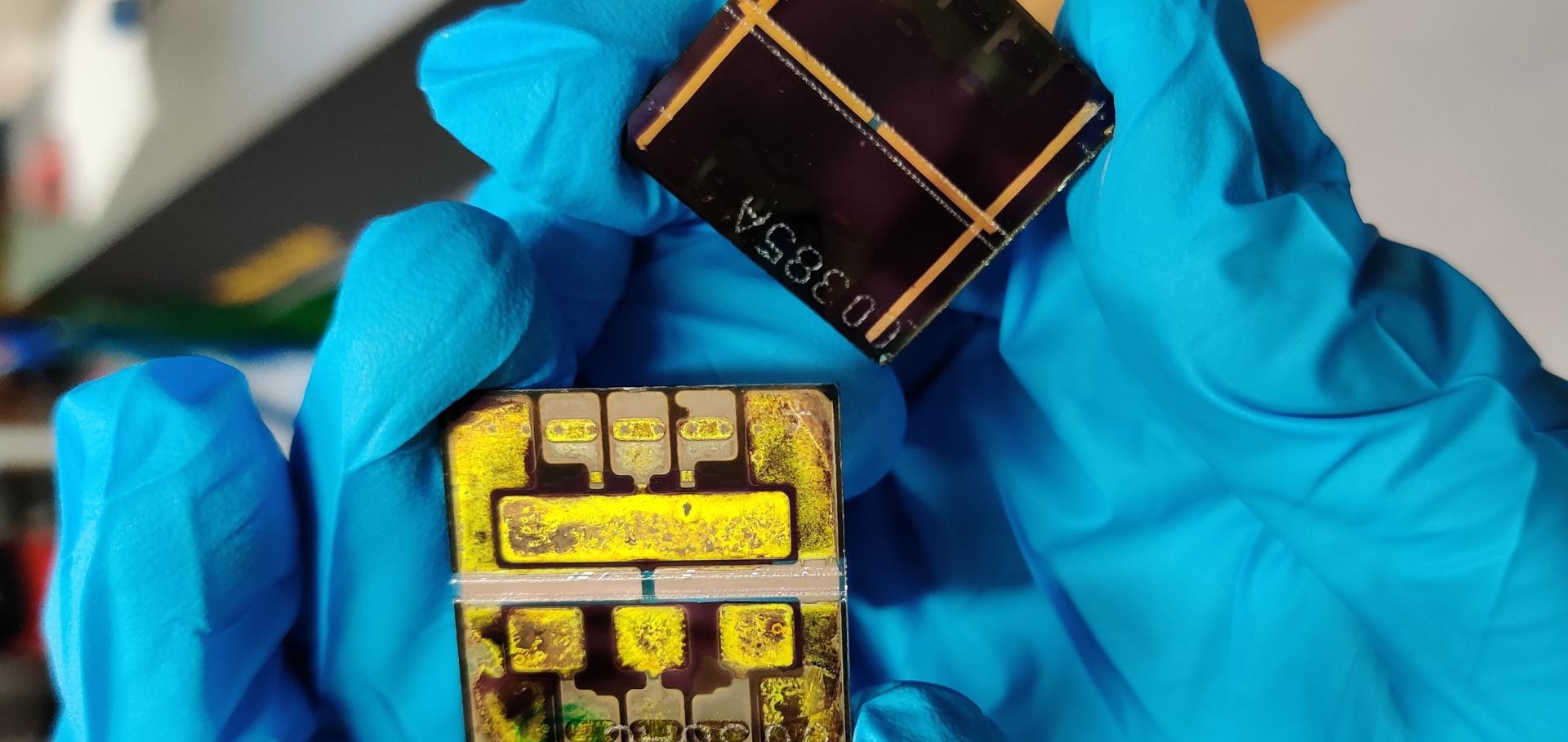Photodegradation of 2D Ruddlesden‐Popper Perovskites: Consequences and Design Principles for Photoelectrochemical Applications
Advanced Science Wiley (2025) e07300
Abstract:
Halide perovskites (HaP), with their exceptional optoelectronic properties and high-power conversion efficiencies in photovoltaic devices, hold promise for photoelectrochemical (PEC) applications in green fuel and chemical production. However, their stability in aqueous environments remains a challenge. This study investigates the stability and degradation mechanisms of the 2D Ruddlesden-Popper phase phenylethyl ammonium lead iodide (PEA(+) 2PbI4) thin films in aqueous electrolytes under dark and illuminated conditions. While PEA(+) 2PbI4 thin films appear to be thermodynamically stable in an aqueous electrolyte with phenylethyl ammonium iodide (PEAI), illumination causes significant photodegradation generating a deprotonated and dehalogenated 2D intercalation product: phenylethylamine-lead iodide, 2PEA(0)-PbI2. The degradation of the 2D semiconductor leads to substantial reduction in the photovoltage, adversely impacting the material performance in photoelectrochemical (PEC) devices. To intercept photo-excited charge carriers in the 2D semiconductor, the I3 -/I- redox is added, which reduced photodegradation. The findings underscore that while catalytic reactions at halide perovskite electrodes in aqueous electrolytes are feasible, reversible and irreversible photodegradation remains a critical limitation that must be addressed in the design of PEC devices employing metal halide semiconductor layers for direct electrochemical energy conversion.Charge Extraction Multilayers Enable Positive-Intrinsic-Negative Perovskite Solar Cells with Carbon Electrodes
ACS Energy Letters American Chemical Society 10:6 (2025) 2736-2742
Abstract:
Perovskite solar cells achieve high power conversion efficiencies but usually rely on vacuum-deposited metallic contacts, leading to high material costs for noble metals and stability issues for more reactive metals. Carbon-based materials offer a cost-effective and potentially more stable alternative. The vast majority of carbon-electrode PSCs use the negative-intrinsic-positive (n-i-p) or “hole-transport-layer-free” architectures. Here, we present a systematic study to assess the compatibility of “inverted”, p-i-n configuration PSC contact layers with carbon top electrodes. We identify incompatibilities between common electron transport layers and the carbon electrode deposition process and previously unobserved semiconducting properties in carbon electrodes with unique implications for charge extraction and electronic behavior. To overcome these issues, we introduce a double-layer atomic layer deposited tin oxide (SnO2) and Poly(2,3-dihydrothieno-1,4-dioxin)-poly(styrenesulfonate) (PEDOT:PSS), yielding up to 16.1% PCE and a retained 94% performance after 500 h of outdoor aging. The study is a crucial step forward for printable, metal-electrode-free, and evaporation-free perovskite PV technologies.A green solvent enables precursor phase engineering of stable formamidinium lead triiodide perovskite solar cells
Nature Communications Nature Research 15:1 (2024) 10110
Abstract:
Perovskite solar cells (PSCs) offer an efficient, inexpensive alternative to current photovoltaic technologies, with the potential for manufacture via high-throughput coating methods. However, challenges for commercial-scale solution-processing of metal-halide perovskites include the use of harmful solvents, the expense of maintaining controlled atmospheric conditions, and the inherent instabilities of PSCs under operation. Here, we address these challenges by introducing a high volatility, low toxicity, biorenewable solvent system to fabricate a range of 2D perovskites, which we use as highly effective precursor phases for subsequent transformation to α-formamidinium lead triiodide (α-FAPbI3), fully processed under ambient conditions. PSCs utilising our α-FAPbI3 reproducibly show remarkable stability under illumination and elevated temperature (ISOS-L-2) and “damp heat” (ISOS-D-3) stressing, surpassing other state-of-the-art perovskite compositions. We determine that this enhancement is a consequence of the 2D precursor phase crystallisation route, which simultaneously avoids retention of residual low-volatility solvents (such as DMF and DMSO) and reduces the rate of degradation of FA+ in the material. Our findings highlight both the critical role of the initial crystallisation process in determining the operational stability of perovskite materials, and that neat FA+-based perovskites can be competitively stable despite the inherent metastability of the α-phase.Water- and heat-activated dynamic passivation for perovskite photovoltaics
Nature Springer Nature 632:8024 (2024) 294-300
Abstract:
Further improvements in perovskite solar cells require better control of ionic defects in the perovskite photoactive layer during the manufacturing stage and their usage. Here we report a living passivation strategy using a hindered urea/thiocarbamate bond Lewis acid–base material (HUBLA), where dynamic covalent bonds with water and heat-activated characteristics can dynamically heal the perovskite to ensure device performance and stability. Upon exposure to moisture or heat, HUBLA generates new agents and further passivates defects in the perovskite. This passivation strategy achieved high-performance devices with a power conversion efficiency (PCE) of 25.1 per cent. HUBLA devices retained 94 per cent of their initial PCE for approximately 1,500 hours of ageing at 85 degrees Celsius in nitrogen and maintained 88 per cent of their initial PCE after 1,000 hours of ageing at 85 degrees Celsius and 30 per cent relative humidity in air.Chloride-based additive engineering for efficient and stable wide-bandgap perovskite solar cells
Advanced Materials Wiley 35:30 (2023) e2211742

